Albatron PX865PE Pro II (865PE): It's Springdale Time
by Evan Lieb on May 23, 2003 2:52 AM EST- Posted in
- Motherboards
Albatron PX865PE Pro II: BIOS and Overclocking
Albatron decides to leverage the Award BIOS for the PX865PE Pro II. We have always enjoyed the way Albatron organizes the layout of their BIOSes, and the PX865PE Pro II is no different.
The PX865PE Pro II's Hardware Monitor (sometimes called PC Health) includes a good deal of information in regards to system activity and readings. These include System and CPU temperatures, CPU, Chassis and AUX fan speeds, Vcore, PSU readings (all rails), and a battery voltage reading. Some features we would like to see added to the PX865PE Pro II's Hardware Monitor are fan control settings for all onboard fan headers and VDIMM/VAGP readings. Otherwise, this section is quite adequate for most users and some enthusiasts.
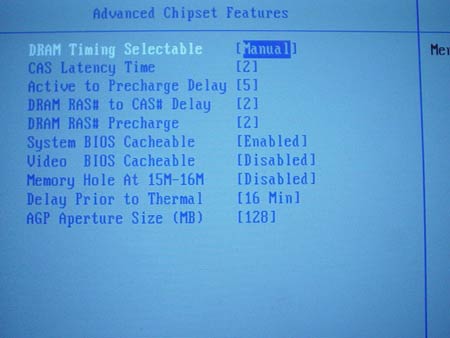
As usual we see a pretty bare Advanced Chipset Features section, as is normal among motherboards based on Intel chipsets. This section includes options for adjusting memory timings such as CAS Latency, Precharge to Active, Active to Precharge, and Active to CMD. ABIT's 875P series of motherboards actually has some additional performance-enhancing options in their Advanced Chipset Features section, so we have seen better DRAM timing options before. But the PX865PE Pro II's Advanced Chipset Features section is still quite adequate.
In the Frequency/Voltage Control section of the PX865PE Pro II's BIOS there is an abundant array of tweaking options. Included in this section are FSB frequency adjusting, memory frequency adjusting, AGP/PCI frequency options, Vcore, VAGP, and VDIMM. A very nice touch to this section is a grayed line below the memory frequency options. This grayed out area automatically adjusts itself in front of your eyes as you choose your FSB. So if you adjust your FSB from 200MHz to 250MHz the greyed out area changes your memory frequency to display exactly what your new frequency will be (in this case from 400MHz to 500MHz if you've set your memory divider to a 1:1 ratio). Overclockers love these types of features.
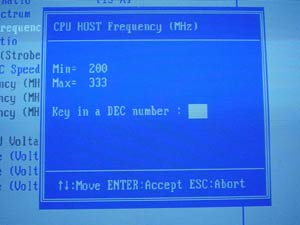
Anyway, we see that the Frequency/Voltage control section allows a FSB as high as 333MHz in 1MHz increments. This is more than enough for most overclockers, though we can see some adventurous users getting beyond 333MHz FSB. We'd like to see Albatron release a BIOS update that allows for up to at least 400MHz FSB. Still, this FSB should do just fine for the vast majority of overclockers.
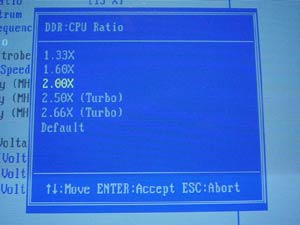
The memory divider options are a bit better than most other 800MHz FSB dual channel DDR motherboards we've used in the past. In addition to DDR266, DDR320, and DDR400 memory frequency options at 800MHz FSB, Albatron adds DDR500 and DDR532 to the mix. You shouldn't expect to be consistently hitting DDR500 in dual channel DDR mode anytime soon (though our labs have been able to get as high as 495MHz memory frequency in dual DDR mode, but that's a whole other review). Still, it's never a bad thing to have more options at your disposal.
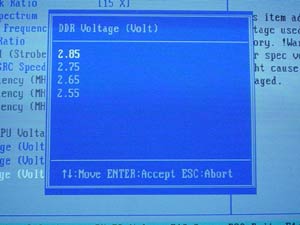
VDIMM adjustments in the PX865PE Pro II's Frequency/Voltage Control section are available as high as 2.85V in 0.1V increments. The PX865PE Pro II automatically sets your VDIMM to 2.55V, which is slightly above spec. This isn't a bad thing, as a higher voltage (to a point) usually allows for a more stable system. Still, anything higher than 2.8V is not a safe bet if you want your memory to last as long as possible, and since you won't really be getting much of an extra memory frequency overclock beyond 2.8V we're not disappointed at all with this VDIMM range.

What keeps the PX865PE Pro II from being great is its lackluster Vcore offering. The PX865PE Pro II is yet another motherboard that adheres to the 1.6V in 0.025V increments rule. This wouldn't be a huge loss if Vcore naturally overvolted at default, but sadly this is not the case. When set to 1.60V the PX865PE Pro II fluctuates between 1.56V and 1.58V using a 1.525V 2.4C Pentium 4 processor. We suggest that Albatron quickly release a BIOS to add Vcore support up to at least 1.70V, while also fixing the undervolting issue. Otherwise serious overclockers will be put off by this board, despite the excellent FSB overclocking results we were able to get on stock Vcore and cooling on this motherboard.
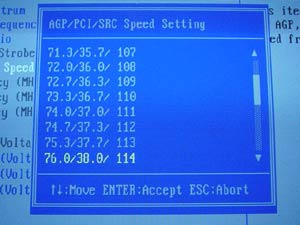
As usual we find a standard AGP/PCI lock in the PX865PE Pro II's BIOS, which is available up to 76MHz/38MHz. You usually don't want to overclock your AGP or PCI buses too far, but in this case 76MHz/38MHz should be fairly safe, though nothing is guaranteed and you could very well damage your AGP and PCI cards if you run them much higher than their default 66MHz/33MHz specification.
Albatron includes some very nice VAGP adjustments. Available as high as 1.80V in 0.1V increments, the vast majority of hardcore overvolting enthusiasts should be very pleased with the VAGP. In our experience 1.6V-1.65V is the max that is necessary if you're a serious video card overclocker.










0 Comments
View All Comments